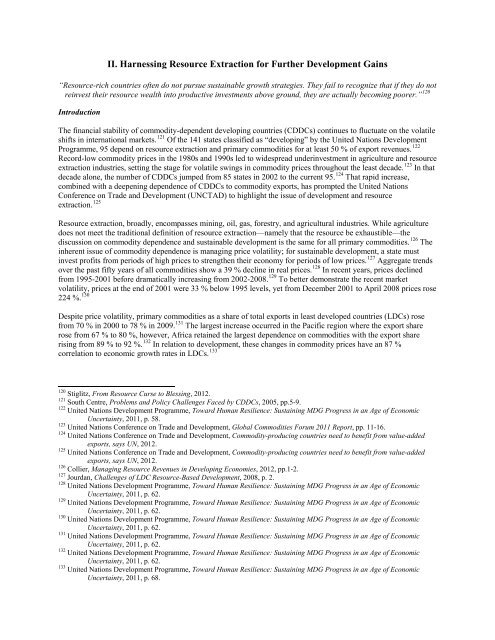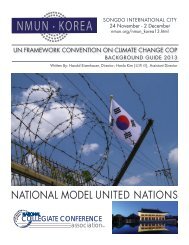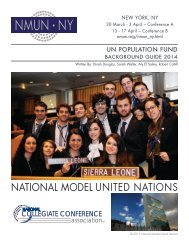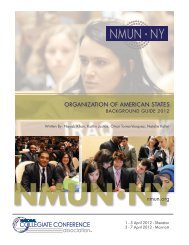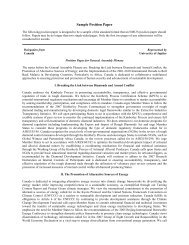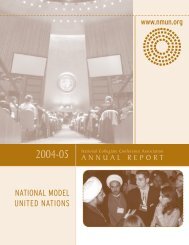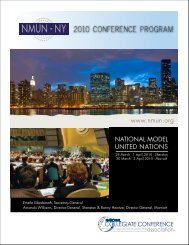UNCTAD Background Guide - National Model United Nations
UNCTAD Background Guide - National Model United Nations
UNCTAD Background Guide - National Model United Nations
Create successful ePaper yourself
Turn your PDF publications into a flip-book with our unique Google optimized e-Paper software.
II. Harnessing Resource Extraction for Further Development Gains<br />
“Resource-rich countries often do not pursue sustainable growth strategies. They fail to recognize that if they do not<br />
reinvest their resource wealth into productive investments above ground, they are actually becoming poorer.” 120<br />
Introduction<br />
The financial stability of commodity-dependent developing countries (CDDCs) continues to fluctuate on the volatile<br />
shifts in international markets. 121 Of the 141 states classified as “developing” by the <strong>United</strong> <strong>Nations</strong> Development<br />
Programme, 95 depend on resource extraction and primary commodities for at least 50 % of export revenues. 122<br />
Record-low commodity prices in the 1980s and 1990s led to widespread underinvestment in agriculture and resource<br />
extraction industries, setting the stage for volatile swings in commodity prices throughout the least decade. 123 In that<br />
decade alone, the number of CDDCs jumped from 85 states in 2002 to the current 95. 124 That rapid increase,<br />
combined with a deepening dependence of CDDCs to commodity exports, has prompted the <strong>United</strong> <strong>Nations</strong><br />
Conference on Trade and Development (<strong>UNCTAD</strong>) to highlight the issue of development and resource<br />
extraction. 125<br />
Resource extraction, broadly, encompasses mining, oil, gas, forestry, and agricultural industries. While agriculture<br />
does not meet the traditional definition of resource extraction—namely that the resource be exhaustible—the<br />
discussion on commodity dependence and sustainable development is the same for all primary commodities. 126 The<br />
inherent issue of commodity dependence is managing price volatility; for sustainable development, a state must<br />
invest profits from periods of high prices to strengthen their economy for periods of low prices. 127 Aggregate trends<br />
over the past fifty years of all commodities show a 39 % decline in real prices. 128 In recent years, prices declined<br />
from 1995-2001 before dramatically increasing from 2002-2008. 129 To better demonstrate the recent market<br />
volatility, prices at the end of 2001 were 33 % below 1995 levels, yet from December 2001 to April 2008 prices rose<br />
224 %. 130<br />
Despite price volatility, primary commodities as a share of total exports in least developed countries (LDCs) rose<br />
from 70 % in 2000 to 78 % in 2009. 131 The largest increase occurred in the Pacific region where the export share<br />
rose from 67 % to 80 %, however, Africa retained the largest dependence on commodities with the export share<br />
rising from 89 % to 92 %. 132 In relation to development, these changes in commodity prices have an 87 %<br />
correlation to economic growth rates in LDCs. 133<br />
120 Stiglitz, From Resource Curse to Blessing, 2012.<br />
121 South Centre, Problems and Policy Challenges Faced by CDDCs, 2005, pp.5-9.<br />
122 <strong>United</strong> <strong>Nations</strong> Development Programme, Toward Human Resilience: Sustaining MDG Progress in an Age of Economic<br />
Uncertainty, 2011, p. 58.<br />
123 <strong>United</strong> <strong>Nations</strong> Conference on Trade and Development, Global Commodities Forum 2011 Report, pp. 11-16.<br />
124 <strong>United</strong> <strong>Nations</strong> Conference on Trade and Development, Commodity-producing countries need to benefit from value-added<br />
exports, says UN, 2012.<br />
125 <strong>United</strong> <strong>Nations</strong> Conference on Trade and Development, Commodity-producing countries need to benefit from value-added<br />
exports, says UN, 2012.<br />
126 Collier, Managing Resource Revenues in Developing Economies, 2012, pp.1-2.<br />
127 Jourdan, Challenges of LDC Resource-Based Development, 2008, p. 2.<br />
128 <strong>United</strong> <strong>Nations</strong> Development Programme, Toward Human Resilience: Sustaining MDG Progress in an Age of Economic<br />
Uncertainty, 2011, p. 62.<br />
129 <strong>United</strong> <strong>Nations</strong> Development Programme, Toward Human Resilience: Sustaining MDG Progress in an Age of Economic<br />
Uncertainty, 2011, p. 62.<br />
130 <strong>United</strong> <strong>Nations</strong> Development Programme, Toward Human Resilience: Sustaining MDG Progress in an Age of Economic<br />
Uncertainty, 2011, p. 62.<br />
131 <strong>United</strong> <strong>Nations</strong> Development Programme, Toward Human Resilience: Sustaining MDG Progress in an Age of Economic<br />
Uncertainty, 2011, p. 62.<br />
132 <strong>United</strong> <strong>Nations</strong> Development Programme, Toward Human Resilience: Sustaining MDG Progress in an Age of Economic<br />
Uncertainty, 2011, p. 62.<br />
133 <strong>United</strong> <strong>Nations</strong> Development Programme, Toward Human Resilience: Sustaining MDG Progress in an Age of Economic<br />
Uncertainty, 2011, p. 68.


